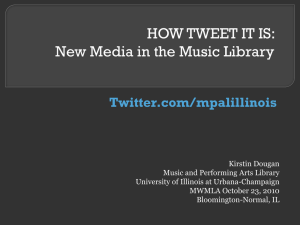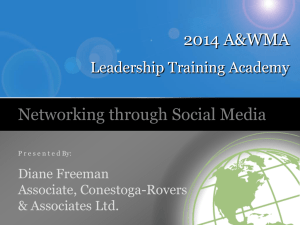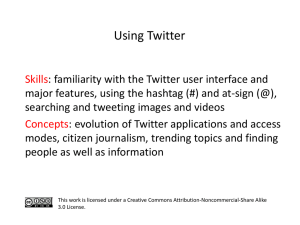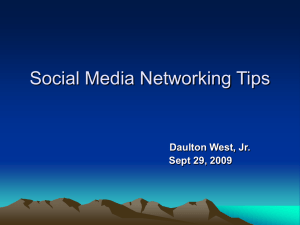Techniques for Improving Student Learning Outcomes
advertisement
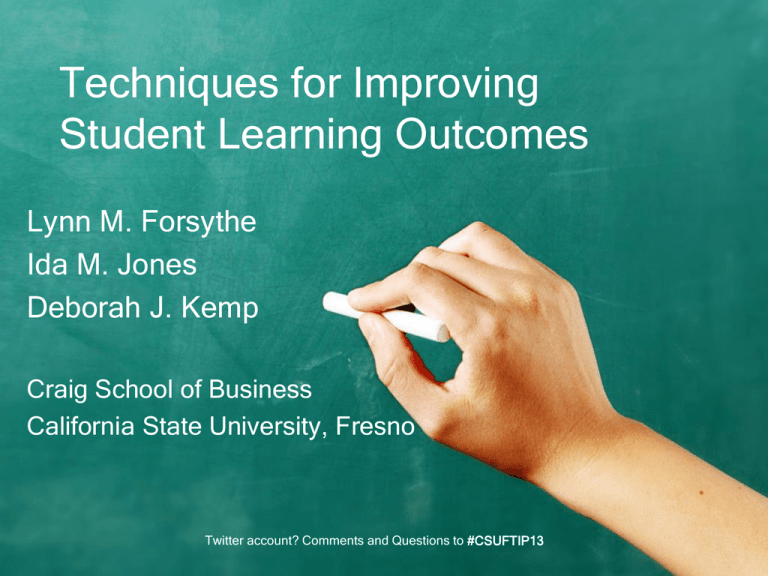
Techniques for Improving Student Learning Outcomes Lynn M. Forsythe Ida M. Jones Deborah J. Kemp Craig School of Business California State University, Fresno Twitter account? Comments and Questions to #CSUFTIP13 Introduction: Central Issues • Student performance in the introductory, required business law class was affected by student’s lack of preparation • Surveys: students failure to read textbook • Diagnostic test: many students cannot read well enough to understand the textbook. • Critical thinking skills needed work Twitter account? Comments and Questions to #CSUFTIP13 Course Redesign • Title V funded • High failure rate course • Implemented Fall 2011Present Our focus Improved student learning (not on just passing students through) Twitter account? Comments and Questions to #CSUFTIP13 Course Redesign: Format • National Center for Academic Transformation (http://www.thencat.org/) • 6 types of course redesign – Range from Supplemental to Linked Workshop • We selected supplemental “supplement[s] lectures and textbooks with technology-based, out-of-class activities, or b) also changes what goes on in the class by creating an active learning environment…” (NCAT http://www.thencat.org/PlanRes/R2R_ModCrsRed.htm) Twitter account? Comments and Questions to #CSUFTIP13 Course Redesign: Organization • Outline of the plan for BA 18 – – – – – Common syllabus Pre-tests and post-tests Low stakes chapter quizzes Critical thinking test Pearson’s My Skills Lab (reading, writing & study skills) • Faculty Updates – Faculty Learning Community format for meetings among all course instructors – Blackboard organization Twitter account? Comments and Questions to #CSUFTIP13 General Reflections • We tried to do too much • Concern about the death of academic freedom Twitter account? Comments and Questions to #CSUFTIP13 Question to Audience • How many teach course with common syllabus, common tests, common finals? • What are your goals? – Rewarding improvement; – Rewarding changes; – Moving from less knowledge to more but not necessarily most – Satisfying accreditation standards – Maintaining rigor & consistency Twitter account? Comments and Questions to #CSUFTIP13 Overview of 5 Topics • Common syllabus – Purpose: to improve student performance across all sections and to make the student experience more consistent • Pre-tests and post-tests – Purpose: to find out how much students know when they enter the class and when they complete the class • Low stakes chapter quizzes on student reading – Purpose: to encourage students to read text chapters and to read them prior to class discussion of the topics Twitter account? Comments and Questions to #CSUFTIP13 Overview of 5 Topics continued • Critical thinking test – Purpose: to measure the ability of students to think critically and improve their critical thinking skills • My Skills Lab by Pearson – Purpose: to improve student skills in reading, writing, and studying Twitter account? Comments and Questions to #CSUFTIP13 Common Syllabus: Goals • To present consistent information across sections • To reduce professor-shopping • To promote learning in the same topic areas – Content – Weight Twitter account? Comments and Questions to #CSUFTIP13 Common Syllabus • What worked: – – – – – – Good idea and works well University template used as a base Includes statement about study expectations Helpful for lecturers and new faculty Developed by group with substantial buy in by faculty Maintains flexibility for faculty • Challenges – Encouraging students to read and use syllabus as a resource – Reaching agreement on some elements (e.g., weight of items) Twitter account? Comments and Questions to #CSUFTIP13 Pre-tests and Post-tests • To measure how much students know at the beginning of the course and be able to compare that with how much they know at the end of the course. • To discover whether course instruction is effective. Twitter account? Comments and Questions to #CSUFTIP13 Pre-tests and Post-tests continued Challenges •Content of the tests – – – – Choosing appropriate topics Finding and creating test questions Determining validity and reliability of questions Determining the optimal length of the test • Weighing pre-test and post-test in overall course grades – Most faculty count the pre-test as 2-4% of the course grade. – The pre-test should count enough for students to take it seriously. Twitter account? Comments and Questions to #CSUFTIP13 Pre-tests and Post-tests continued • Administering the pre-test – Online or not – During class time or not • Should we inform students that the pre-test questions will be on the final? • Discouraging teaching to the test: a delicate balancing act. Twitter account? Comments and Questions to #CSUFTIP13 Pre-tests and post-tests continued • Is this a movement towards a common final? • What needs improvement? – The current pre-test is not evenly distributed across the material. – It does not include many application questions. It tests terminology. – Different business law texts use various terms for the same concepts. Twitter account? Comments and Questions to #CSUFTIP13 Low Stakes Chapter Quizzes • To encourage students to read the assigned chapters before class discussion. • To provide students with feedback on their reading and comprehension. Twitter account? Comments and Questions to #CSUFTIP13 Low Stakes Chapter QuizzesStructure • Each quiz: 5 randomly selected questions from a question pool, 10 minutes to answer • Students could retake the quizzes; initially unlimited times, then reduced to 5 times • The highest score was counted towards their course grade. • Students completed the quizzes on Blackboard outside of class. • Source: test banks from textbook publishers • Student and faculty handouts are available on the conference web site. Twitter account? Comments and Questions to #CSUFTIP13 Low Stakes Chapter Quizzes: Successes • What Worked – Results are immediate. – Students believed the quiz encouraged them to read the material Twitter account? Comments and Questions to #CSUFTIP13 Low Stakes Chapter Quizzes: Challenges • Challenges – Weight of quizzes – Blackboard glitches that required some manual grading – Security of quiz questions – Small size of quiz pool – Nature and type of questions (e.g., need more application questions) Twitter account? Comments and Questions to #CSUFTIP13 Low Stakes Chapter Quizzes: Reassessment • What needs improvement? – Assisting students to read and write effectively – Consistency among faculty as to how long quizzes are available (e.g., 3 days, one week) – Consistency in administration by faculty (e.g., determining as a group whether students could see quiz answers) Twitter account? Comments and Questions to #CSUFTIP13 Critical Thinking Test • To improve students’ ability to read and analyze text material • To improve students’ ability to apply legal theories to other situations • To improve students’ ability to solve problems Twitter account? Comments and Questions to #CSUFTIP13 Critical Thinking Test • Challenges – Finding an appropriate test of critical thinking – Determining what elements of critical thinking to assess • Worked/Didn’t work – Test selected was inappropriate • Tested critical thinking vocabulary, • Did not clearly test critical thinking skills • Students did not find it to be useful Twitter account? Comments and Questions to #CSUFTIP13 My Skills Lab (Pearson)-Goals • To help improve student reading skills • To help improve student writing skills • To help improve student study skills Twitter account? Comments and Questions to #CSUFTIP13 My Skills Lab (Pearson)Challenges • My Skills Lab—reading/writing diagnostic test scores – Get an accurate diagnostic (student resistance if haven’t had problem in class) – Difficult to correlate grades and reading ability on scale and difficult to do easily – Pearson should coordinate with professors and the University – University should do more to coordinate efforts to develop an effective system to help students become better prepared • What Worked – Student perceptions of value – Diagnostics demonstrated need Twitter account? Comments and Questions to #CSUFTIP13 Course Redesign: What now? • SIMPLIFY • Join FLCs for critical thinking & My Skills Lab • My Skills Lab – Look at diagnostic test scores – Grading – Assess how well/whether it accomplished the related goals • Assess the impact of the quizzes – Improved reading skills? – What’s the appropriate value to encourage taking quizzes • Revise the pre-/post-test • No critical thinking test-more research needed • New effort to improve learning: Develop in class active learning activity and quick assessment of it Twitter account? Comments and Questions to #CSUFTIP13 Where to go next • Update common syllabus; add syllabus quiz • Common final • Common assignment • Continue to make adjustments to the pre-test and post-test structure and the low stakes chapter quizzes Twitter account? Comments and Questions to #CSUFTIP13 Images: license from dreamstime.com & classroomclipart.com PowerPoint template (free) http://www.smiletemplates.com/lastadded/powerpoint-templates/0.html
